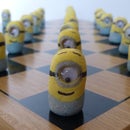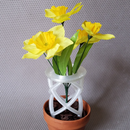Introduction: 3D Printed Cam (Made It at TechShop)
This is an example of a 3D printed moving assembly created as a single part on a Stratasys uPrint, a business-grade 3D printer available to consumers at places such at TechShop. Once printed, a long soak in a special solution removes all of the support material, leaving a moving assembly that did not require any sanding!
Read on to see additional images showing how this assembly could be used as a non-powered attachment for a drone.
Step 1: The Assemby in Action
The basic idea is to have a mechanism that can be deployed by a drone that does not require the additional complexity and power of motors and other electronics (drone CAD files courtesy of Horus Drones).
The Jaws (YELLOW) are initially folded up to prevent getting caught during transit and also allows the assembly to be deployed in small spaces.
When the assembly is lowered onto a hard surface, the Inner Shaft (GREEN) slides up, releasing the Jaws to be used as a hook.
While the Jaws are designed to rotate open by gravity alone, there are Posts (RED) for attaching springs or elastic bands which actively deploy the Jaws like a rock climber's cam to pick up objects by pushing against the inside walls.
Step 2: Additional Images
Here I show how the 2-Jaw assembly can easily be modified into a 4-Jaw version, and since the support material is dissolvable, it can be 3D printed just as easily.
This mechanism was designed to highlight a design that could only be 3D printed as a single mechanism, so even if the individual parts were 3D printed, they could not be assembled. The exploded view shows how 3D printing is able to eliminate assembly steps by printing the entire mechanism with the pins and sliding features already in place.
NOTE: The Gripper Pads (ORANGE) were intended for an even more advanced 3D printer that could also print using materials with different durometers (hardnesses). For this prototype I wrapped the Jaws with clear silicone tape.
Step 3: The 3D Printer
With the UPrint 3D printer, the part material and the support material are very similar in color, so at first glance it looks like the assembly is completely encased, but after a few hours of soaking, the assembly moves freely.

Participated in the
Make it Move Contest 2016

Participated in the
3D Printing Contest 2016















